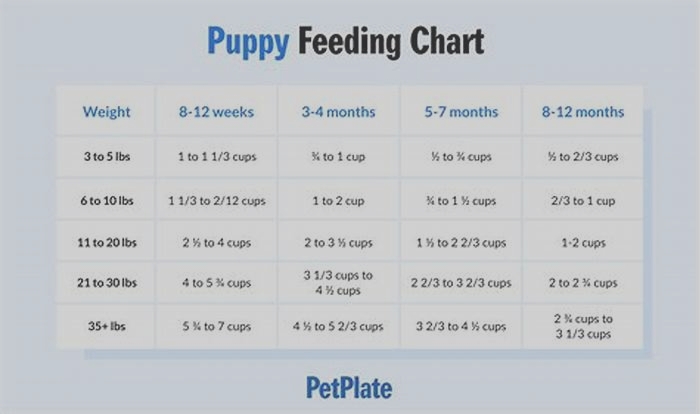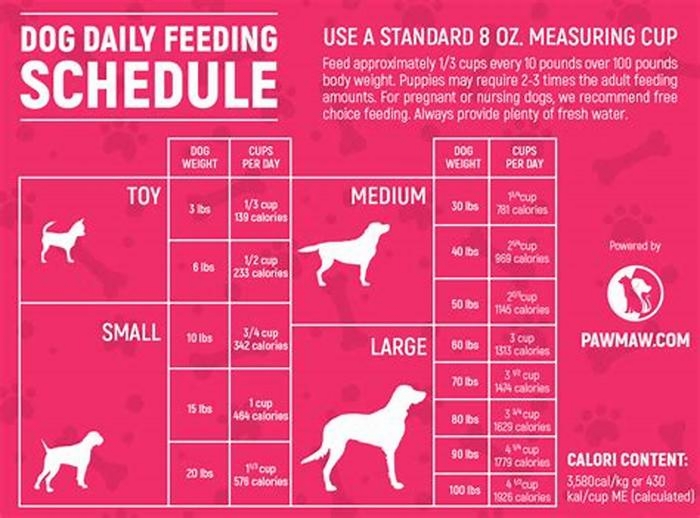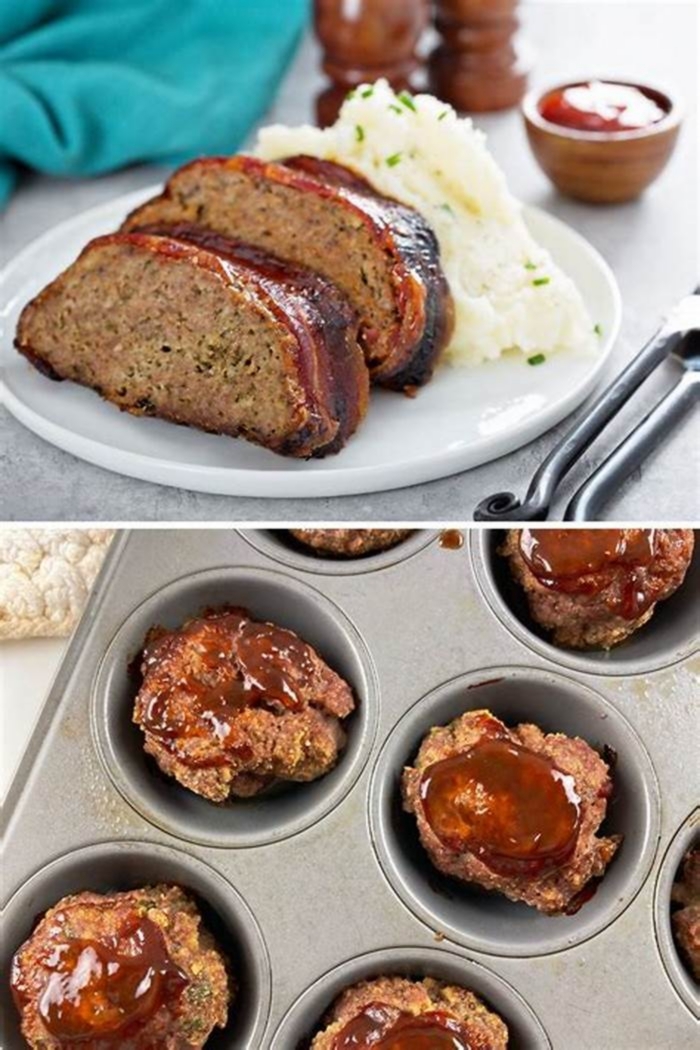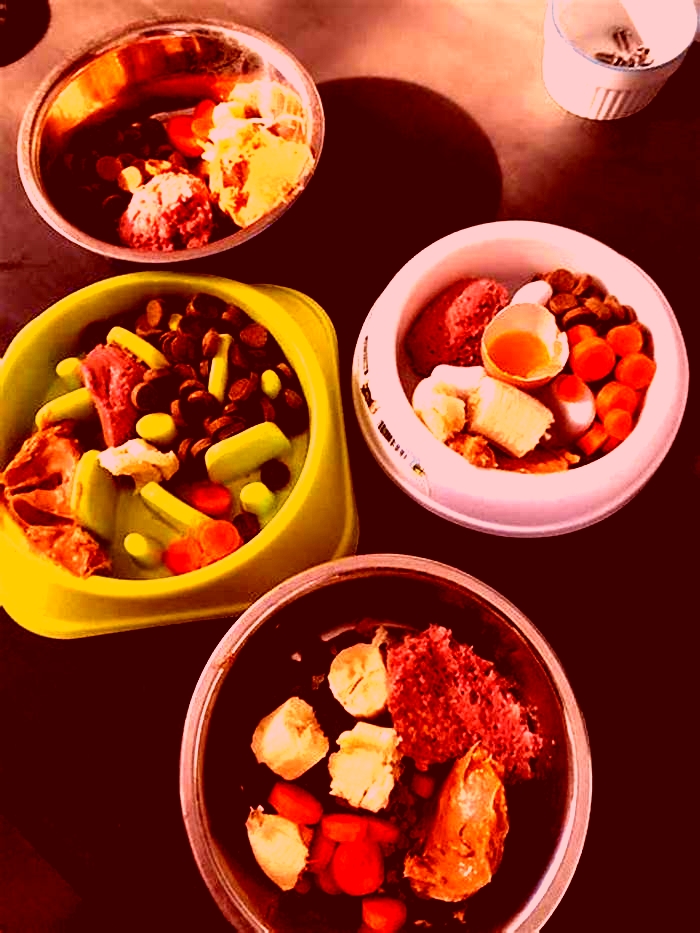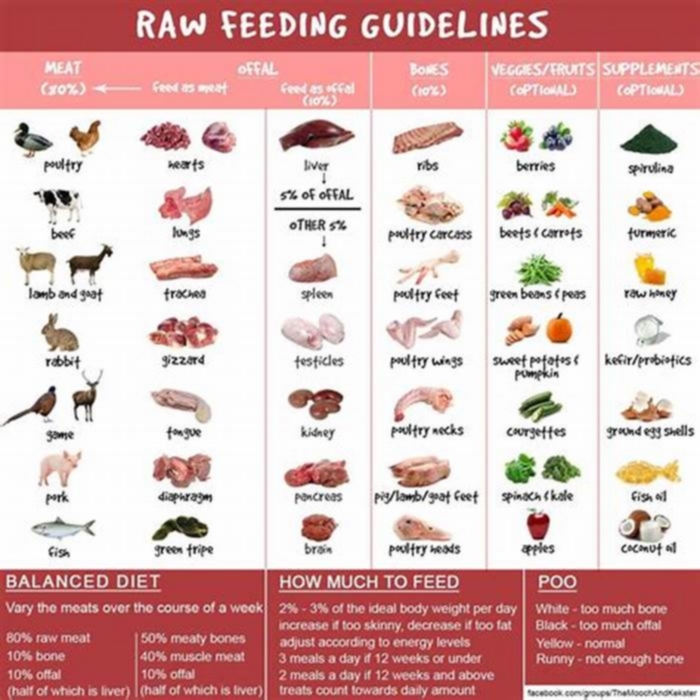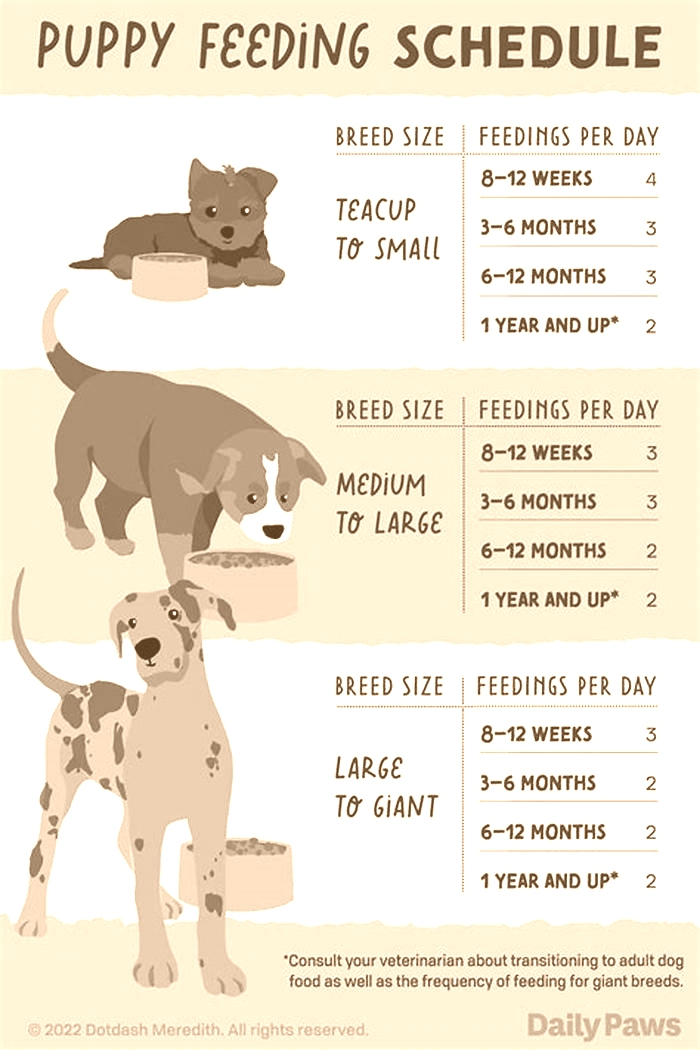Do dogs need 2 meals a day

The Pros And Cons Of Feeding Your Dog Once A Day
The most common feeding schedule for adult dogs is one or two meals daily. I recommend that most people feed their dogs twice a day. But feeding your dog once a day can work well in some circumstances.
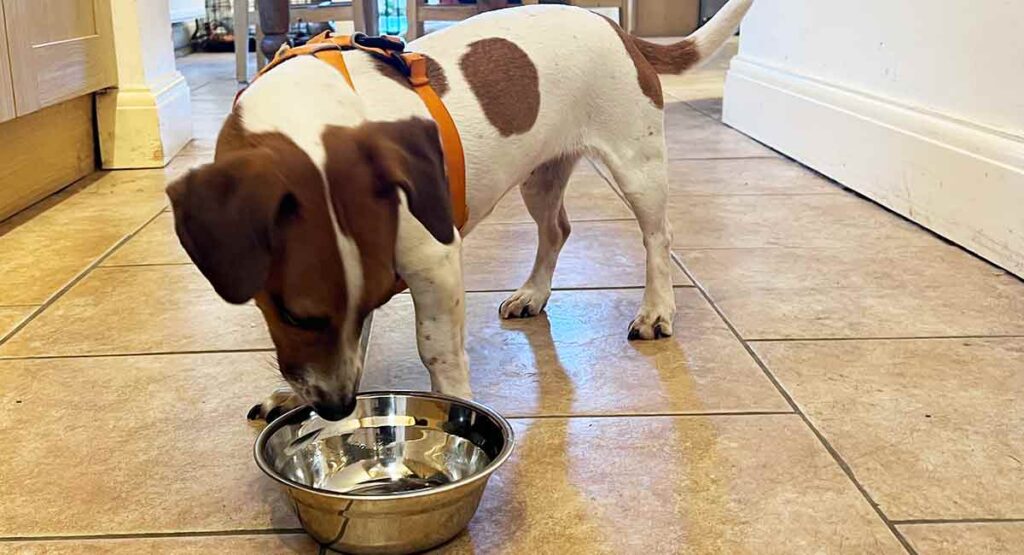
The best feeding schedule for your individual dog will depend partly on the type of food you give them. And my advice is based on my own forty years experience of feeding both kibble and raw, to dozens of different dogs.You can check out what I feed my own dogs each day in this article
Considerations
Is it cruel to feed a dog once a day?
The short answer is no. Traditionally almost all adult dogs were fed once a day. This was the norm when I was a kid. The rationale behind this schedule is that dogs are carnivores, and it is natural for them to eat a large amount of food in one go, and then fast for many hours, before eating again.
In those days most dogs were fed on a mixture of canned (wet) dog food, and dog biscuits together with scraps leftover from human meals.
However, most modern dogs are fed on kibble. And with dry food, feeding once a day has some disadvantages. Lets dig into those, and help you decide how often to feed your dog.
Natural feeding patterns
Its true that your dog is genetically almost identical to the wolves from which they descend. Wild wolves or other dog species hunting in groups may bring down a large prey animal, and feast on it. Then not eat for a day or two.
Its also true that dogs have been catching much smaller prey and scavenging from humans for thousands of years, and have adapted well to eating smaller and more frequent meals.
Pros and cons large vs smaller meals
Feeding once a day is convenient. And with a raw diet, it can be safe and satisfactory for most medium to large dogs
The natural diet of a dog, raw meaty bones, organs, eggs, and even invertebrates such as worms and beetles, are all processed very quickly by a dogs digestive system. Its designed perfectly for the job. And because there are no fillers or carbs in this food, it isnt very bulky. Everything is digested with little waste.
With kibble, feeding once a day only, can be problematic for some dogs. Its all to do with the portion size. And of course once daily meals are twice as big as twice daily meals.
Big dogs
It can be risky to feed a large or deep chested dog their whole days ration of kibble in one hit. Thats because these types of dog are more prone to suffering from bloat.
When we feed our dogs on kibble, we are asking the dogs digestion to take on a task that it isnt quite designed for. Along with the protein, fat and minerals that your dog needs, are a lot of bulky fillers.
While the food looks and feels light and compact when you pour it into the bowl, at that point it is completely dehydrated. It starts to swell up inside your dog as soon as they start to drink.
Its worth thinking about what happens to the bowl of kibble your dog just ate, when they head over to their water dish. Try dropping a few pieces into a glass of water to see how much they expand!
Your dog needs that water so dont ration it. But be aware that they can end up with a lot of heavy food sitting in their stomach, and this may increase their risk of suffering from bloat.
Little dogs
Small dogs often need a minimum of two meals per day, in order to feel well. My own Jack Russell terrier will often vomit if she misses her breakfast, and this is quite common in little dogs.
Some small dogs also find it hard to consume enough in one sitting to keep their weight up. So feeding twice a day may be necessary for many dogs weighing much less than around 20lbs.
This rule applies with both raw food and kibble.
Puppies
All puppies need feeding more frequently than adult dogs.
Most kibble fed puppies need at least four meals a day until they are three months old, then three meals a day until six months.
Some raw fed puppies can drop a portion a bit sooner.
Food should be fun
Aside from the health and safety issues around eating kibble, food is a source of great pleasure in our lives, and dogs feel the same way. They enjoy their meals. And look forward to the next one.
Most dogs eat kibble quite fast. Its unusual for a dog to take more than five minutes over their meal. And twenty four hours is a long time for a kibble fed dog to go between meals, especially when the last meal was over so quickly!
Raw meaty bones take a lot of time to consume, and can keep a dog occupied happily for half an hour or more. But even so I think there is a lot of pleasure to be gained if this experience happens twice in each day rather than once.
Which is best? One meal or two?
Your adult dog will most likely thrive whether you divide their daily ration into one meal or two. However, if your dog is large or deep chested, and fed on kibble, I recommend you feed twice daily, dividing that ration into a morning and evening feed.
Obviously, twice daily meals doesnt mean twice the quantity. You feed the same daily ration but divide it into smaller portions
I do think it means twice the fun though!
And while once daily feeding is suitable for all but the smallest raw fed dogs, I feed all my dogs raw, and, twice daily
Let me know what you decide to do!
Im always interested to hear from readers about how they feed their dogs, so do drop a comment in the box below!
Get Pippa's free dog training tips delivered to your inbox
How Often Should Dogs Eat?
Paid Advertisement
Among the many questions new and experienced dog owners face is an especially important one. How often should dogs eat? Diet and nutrition are crucial components to keeping your dog a healthy member of the family for years to come.
Though theres no hard-and-fast rule to how often a dog should eat, twice a day is generally a good place to start. However, more important than feeding frequency is meal portion size. Portion size may vary based on breed, age, and health condition, and settling on the right amount can be tricky.
Dog meal delivery services can make it easy to serve your canine companion delicious, nutritious, and appropriately-portioned meals that even humans can eat. Ollie is a service that delivers fresh, human-grade dog food customized for your pups unique nutritional needs. Ollie works with vet nutritionists to formulate a perfect plan specifically for your dog based on weight, breed, and allergies. Plus they make it easy for us humans all of Ollies recipes are pre-portioned and your pup will be set up with their own feeding schedule so you dont have to worry about overfeeding or underfeeding.
What Affects How Often a Dog Should Eat?
Veterinarians recommend feeding a dog at least twice per day. Dogs with medical issues or dietary needs may require specialized feeding schedules or restrictions on what they eat. Talk to your veterinarian about your dogs eating habits to make sure youre meeting their nutritional needs and healthcare requirements.
Breed plays a large role when deciding how often to feed your dog. Common large breed dogs, for instance, will often require more feedings and more calories per day than medium and small breed dogs.Age is also another important consideration. The caloric requirements for a two-month-old Yorkshire Terrier varies greatly compared to a two-year-old Yorkie.
How Much Should Puppies Eat?
A fresh meal servicelike Ollie helps change your feeding approachas your dog changes ages from puppy to adult so you dont have to worry about portions during different life stages.
Since puppies are growing rapidly, they need more food than adult dogs. Puppy nutrition is crucial for developing a foundation for future growth, as well as their bone and organ development. Puppies must have a specific amount of calcium in their diet, otherwise, they can develop metabolic bone disease or orthopedic conditions like early-onset arthritis. Toy-breed puppies, in particular, are prone to hypoglycemia.
Puppies need small, frequent feedings. For the first few months of a puppys life, they will need small meals of food throughout the day as they transition from their mothers milk to solid food. Starting around four months, puppies can begin eating about three times a day, and after that, puppies will quickly graduate to twice-a-day feedings.

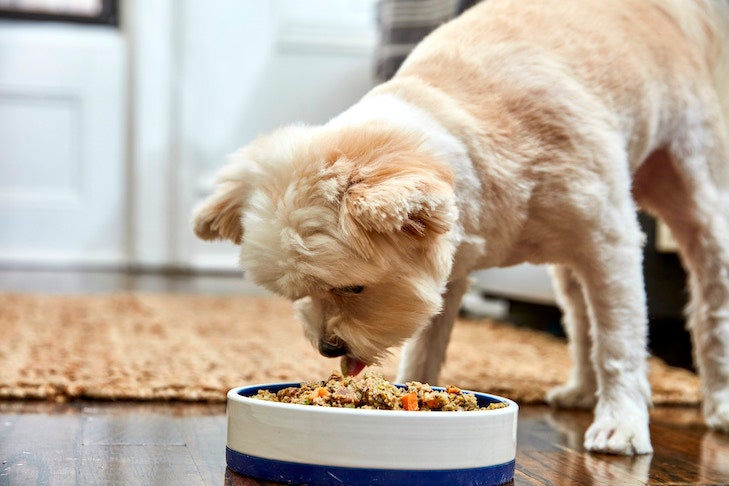
Feeding them three or four times per day makes it easier for puppies to digest and help keep energy levels consistent. However, its important to not overfeed them, since overweight puppies are more likely to become overweight adult dogs.
Toy-breed puppies will need 4 to 6 meals per day for the first three months of their lives. Medium-breed puppies will require three meals per day, and large-breed puppies typically need 3 to 4 meals per day. Though the breed is an important consideration, metabolism and energy levels can vary by up to 30 percent. Therefore, youll need to proportion meals accordingly.
Even though puppies grow quickly, its important to keep caloric intake and food amount consistent from four to twelve months of age. Puppies use fewer calories for growth as they become older. This comprehensive puppy feeding chart has vet-recommended guidelines on how much and how often to feed your puppy.
How Much Should Adult Dogs Eat?
Dont let your dog trick you into more mealtimes with adorable puppy dog eyes. Most dogs only require two meals a day, but if you catch your dog begging, an occasional healthy treat can help.
The trick is to make sure youre not feeding your dog more than is recommended. Food labels can be misleading or confusing. Generic feeding charts may over-calculate how much to feed a dog, or use outdated information.
To determine how much food to feed your dog, you should start by knowing your dogs estimated adult weight. Most large breed dogs will weigh between 50 to 150 pounds, while small breeds weigh under 20 pounds. Knowing the weight of your dogs same-sex parent can also be an excellent guide.
From there, you can use the estimated weight to determine how many calories dogs need per day.
What Sort of Feeding Schedule Works?
Free-feeding, or leaving food available to dogs at all times, is often not recommended by veterinarians. For multi-species or multiple-dog households, free-feeding makes it difficult to account for different diets and to track each dogs intake. Additionally, free feeding can lead to obesity when dogs overeat.
Sticking to a schedule can help your canine companion avoid grazing, feel like part of the family, and can encourage good mealtime behavior. You should plan a feeding schedule by consulting with your veterinarian.
Why Ollie?
Feeding dogs a diet made with natural, real ingredients can do wonders for their overall well-beingit can promote heart health, increase energy level, make their coat shinier, their breath smell better, improve eyesight and even impact poop. With Ollie, all the prep work is done for you so you dont have to worry about when, how much, or life stages when it comes to feeding. Were providing 50% off to the AKC audience for their first trial box, delivered straight to your home.
- Ingredients: Ollies food is made only with whole, human-grade ingredients sourced from reputable farms and approved by vets. They never use fillers, by-products, artificial flavors, or preservatives in any of their recipes. Each recipe is cooked by hand at low temperatures in small batches in a USDA-regulated kitchen so you know your pup is getting the best.
- Easy Schedule:All of Ollies recipes are pre-portioned and stored in the freezer plus you will receive a puptainer to keep your pups food fresh in case you feed your dog before your morning coffee. Ollie also takes care of us humans, Ollie is delivered directly to your door in as little as 2 days, on your schedule.
- Health Benefits: The proof is in the results. Ollie dogs have reported shinier coats, decreased allergies, improved appetite, and more.
Ollies freshly cooked food is the simplest way to keep your dog happy and healthy at any age. Our five delicious recipes were formulated with vet nutritionists and ensure mealtime stays fresh and exciting for your pup. Visit Ollie.com, tell us all about your pup, and well create a custom meal plan just for them.

